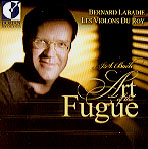As if to immediately dispel any notion that Bach’s Art of Fugue is merely a theoretical educational work, Bernard Labadie and Les Violons du Roy begin their discerning, eminently listenable strings-and-continuo setting of Bach’s keyboard masterpiece with gorgeous, rich string colors, elegant, long-limbed lines, and firm, confident articulation. The energy, which becomes downright danceable in some sections, is brought to an even higher pitch in fugues V, VII, and XII. Throughout, Labadie, who made the transcription and also produced his own completion of the final quadruple fugue, demonstrates a keen ear for sonority but also a practical and considerate judgment for keeping the textures as clear and clean as possible (a facility he showed to even greater effect in his full-fledged arrangement of Bach’s Goldberg Variations, also on Dorian, see reviews archive).
However, if nothing else, such attempts at transcription–and this one is no exception–ultimately make the case for this work’s stubborn, intrinsic keyboard temperament. The Art of Fugue is unquestionably a set of keyboard pieces and, as with many other of Bach’s strictly keyboard conceptions, fights against efforts to expand its originally conceived weight and dimension. Within the bounds of a string quartet setting–or brass or saxophone or whatever–this effect is not as noticeable; but as soon as multiple instruments are added to the parts, and especially in the lower registers, textures refuse to remain lucid, most evident here in several of the fugues played by the full ensemble–Contrapunctus I, VI, and IX, for example. In contrast, the fugues and canons performed by smaller, one-to-a-part groups retain clarity in the inner lines and don’t seem out of proportion–that is, there’s balance among the voices that’s hard to maintain in the full-ensemble context.
This is not to say that the current performance isn’t perfectly enjoyable and worthy of consideration along with other first-rate yet interpretively different offerings, such as the Keller Quartet (ECM), Delmé Quartet (Hyperion), Neville Marriner on modern instruments (Philips), or Jordi Savall on period instruments (Naïve/Astrée). Nor should it be regarded as necessarily more useful in its analytical value than various other treatments: because of the music’s structural consistency and Bach’s straightforward scoring, listeners with almost any instrumental preference can find a version to suit their tastes in assorted readings by saxophones, brass, recorders, piano, harpsichord, organ, or viols. However, Les Violons du Roy not only is Canada’s finest chamber orchestra and one of the world’s most important arbiters of Baroque performance, but in Labadie it also has one of today’s most eloquent, intelligent, and imaginative conductors.
If you don’t pay attention to these outstanding musicians, you’re missing something significant at best and memorable at the very least. The orchestra’s solo players–including violinists Nicole Trotier and Pascale Giguère and cellist Carla Antoun–are among the world’s finest, and they have numerous opportunities here to show their individual artistry–as in Contrapunctus VIII, a three-voice triple fugue that Labadie scored for violin, viola, and cello, or the two-voice “canon at the 12th”, set for violin and cello. Other canons, which Labadie chose to mingle among the fugues rather than leave them out altogether (as some transcribers and recordings do) or bunch them at the end, are performed on organ or harpsichord. As an appendix, the two arrangements for two harpsichords of Contrapunctus XIII are included, played on two organs.
The beauty of this work–and of a recording that features a variety of textures and colors for the individual fugues–is that you can sample bits of it or listen straight through and gain insight and enjoyment, as well as a renewed appreciation for Bach’s awesome genius. And such listening sessions are made that much more pleasant both by Dorian’s outstanding sonics, made in the ideal acoustical environment of Quebec’s Le Domaine Forget, and by the exceptionally detailed, informative–and readable–liner notes.
































